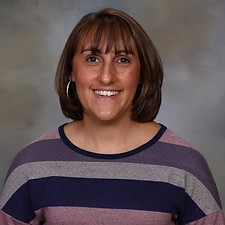Kindergarten Curriculum
Meet Our Kindergarten Teacher!
Hi! My name is Jenna Richardson and I have been teaching Kindergarten at St. John for the past 8 years!
I can’t wait to meet you and your child and watch him/her grow throughout the year. You will be amazed at the growth your child will gain this year. Kindergarteners will grow educationally, socially and emotionally throughout the year. My hope is that they leave my classroom with a love and understanding of reading! They will also understand how numbers work, how to add and subtract and a lot of other fun math skills! Lastly, they will learn how to work with others and make some long term friends!
Ohio Standards

Jenna Richardson
St. John Schools follow the curriculum that Ohio Standardized. Below is a summary of what Ohio expects teachers to teach in Kindergarten in each subject.
English Language Art
-
Conventions of Standard English
-
Demonstrate command of the conventions of standard English grammar and usage when writing or speaking.
-
Demonstrate command of the conventions of standard English capitalization, punctuation, and spelling when writing.
-
-
Vocabulary Acquisition and Use
-
Determine or clarify the meaning of unknown and multiple-meaning words and phrases based on kindergarten reading and content.
-
With guidance and support from adults, explore word relationships and nuances in word meanings.
-
Use words and phrases acquired through conversations, reading and being read to, and responding to texts.
-
Mathematics
-
Counting and Cardinality
-
Know number names and the count sequence.
-
Count to tell the number of objects.
-
-
Operations and Algebraic Thinking
-
Understand addition as putting together and adding to, and understand subtraction as taking apart and taking from.
-
-
Measurement and Data
-
Identify, describe, and compare measurable attributes.
-
Classify objects and count the number of objects in each category.
-
-
Operations and Algebraic Thinking
-
Understand addition as putting together and adding to, and understand subtraction as taking apart and taking from.
-
-
Geometry
-
Identify and describe shapes (squares, circles, triangles, rectangles, hexagons, cubes, cones, cylinders, and spheres).
-
Describe, compare, create, and compose shapes.
-
Science
-
Earth and Space Science
-
Weather changes are long-term and short-term.
-
The moon, sun and stars can be observed at different times of the day or night.
-
-
Physical Science
-
Objects and materials can be sorted and described by their properties.
-
Some objects and materials can be made to vibrate to produce sound.
-
-
Life Science
-
Living things have specific characteristics and traits.
-
Living things have physical traits and behaviors, which influence their survival.
-
Social Studies
-
History
-
Time can be measured.
-
Personal history can be shared through stories and pictures.
-
Symbols and practices of the United States include the flag, Pledge of Allegiance and the National Anthem. Other nations are represented by symbols and practices too.
-
-
Geography
-
Terms related to direction and distance, as well as symbols and landmarks, can be used to talk about the relative location of familiar places.
-
Models and maps represent real places.
-
Humans depend on and impact the physical environment in order to supply food, clothing and shelter.
-
Individuals are unique but share common characteristics of multiple groups.
-
-
Government
-
Individuals share responsibilities and take action toward the achievement of common goals in homes, schools and communities.
-
The purpose of rules and authority figures is to provide order, security and safety in the home, school and community.
-
-
Economics
-
Individuals have many wants and make decisions to satisfy those wants. These decisions impact others.
-
Goods are objects that can satisfy an individual's wants. Services are actions that can satisfy individual's wants.
-

